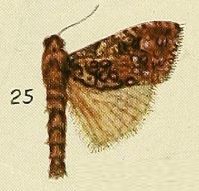Mountelgonia is a genus of moths belonging to the family Cossidae, Metarbelidae.
Mountelgonia percivali is a moth of the family Cossidae. It is found from the areas east of the summits of Mount Elgon to the western highlands of Kenya. It is probably also found on the western side of Mount Elgon in Uganda. The habitat consists of dry Afromontane forest at high altitudes.
Mountelgonia lumbuaensis is a moth of the family Cossidae. It is found in the Mau Forest complex in the south-western highlands of Kenya. The habitat consists of both wet and dry Afromontane forest at high altitudes.
Mountelgonia abercornensis is a moth of the family Cossidae. It is found in north-eastern Zambia. The habitat consists of woodland mosaic at high elevations.
Mountelgonia thikaensis is a moth of the family Cossidae. It is found east of the eastern Great Rift Valley in the central highlands of Kenya. The habitat consists of a mosaic of scattered tree grassland and riverine forests.
Mountelgonia urundiensis is a moth of the family Cossidae. It is found on the high central plateau of Burundi. The habitat consists of forest/woodland mosaic with riverine forests at high elevations.
Mountelgonia pagana is a moth of the family Cossidae. It is found in north-eastern Rwanda. The habitat consists of a mosaic of wooded savanna, farmland and dry forests.
Moyencharia mineti is a moth of the family Cossidae. It is found in southern Chad and probably also the Central African Republic. The habitat consists of a mosaic of riparian forests, open woodland and wooded floodplain grassland at low elevations.
Moyencharia joeli is a moth of the family Cossidae. It is found in north-central and north-east central Nigeria and probably north-western Cameroon.
Moyencharia winteri is a moth of the family Cossidae. It is found in south-western Sudan and the north-eastern part of the Democratic Republic of the Congo. The range probably extends into the Central African Republic.
Moyencharia herhausi is a moth of the family Cossidae. It is found in south-western Burkina Faso and probably south-eastern Mali. The habitat consists of a mosaic of wooded farmland and Sudanian woodland with pockets of dry and riparian forests at low elevations.
Moyencharia sommerlattei is a moth of the family Cossidae. It is found in Guinea. The habitat consists of various forest types at low elevations.
Moyencharia ochreicosta is a moth of the family Cossidae. It is found from western Burkina Faso south through north-eastern and south-eastern Ghana to south-eastern and east-central Nigeria. It is probably also present in Togo and Benin. The habitat consists of rain forests and riparian forests at low elevations.

The Metarbelidae are a family of the Cossoidea also called the carpenter or goat moths, and is sometimes treated as a subfamily, Metarbelinae of the Cossidae. No synapomorphies are shared with the Cossidae based on adult morphology. The family Metarbelidae was first described by Embrik Strand in 1909.

Metarbela is a genus of moths in the family Cossidae described by William Jacob Holland in 1893.
Arbelodes griseata is a moth in the family Cossidae. It is found in South Africa, where it has been recorded from Gauteng, the North-West Province and the Limpopo Province. The habitat consists of moist/dystrophic subtropical savannas and arid/eutrophic savannas.
Arbelodes haberlandorum is a moth in the family Metarbelidae. It is found in South Africa, where it has been recorded from the Cederberg. The habitat consists of submontane and montane riparian areas.
Arbelodes iridescens is a moth in the family Cossidae. It is found in north-eastern South Africa, where it has been recorded from Gauteng and Mpumalanga. The habitat consists of Afromontane forests and thickets.
Arbelodes kruegeri is a moth in the family Metarbelidae. It is found in South Africa, where it has been recorded from the Cederberg. The habitat consists of submontane and montane woody riparian areas.
Arbelodes mondeensis is a moth in the family Metarbelidae. It is found in South Africa, where it has been recorded from the Eastern Cape. The habitat consists of thickets and tree clumps.
